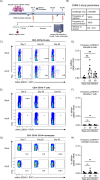B cell receptor dependent enhancement of dengue virus infection
- PMID: 39480886
- PMCID: PMC11556684
- DOI: 10.1371/journal.ppat.1012683
B cell receptor dependent enhancement of dengue virus infection
Abstract
Dengue virus (DENV) is the causative agent of dengue, a mosquito-borne disease that represents a significant and growing public health burden around the world. A unique pathophysiological feature of dengue is immune-mediated enhancement, wherein preexisting immunity elicited by a primary infection can enhance the severity of a subsequent infection by a heterologous DENV serotype. A leading mechanistic explanation for this phenomenon is antibody dependent enhancement (ADE), where sub-neutralizing concentrations of DENV-specific IgG antibodies facilitate entry of DENV into FcγR expressing cells such as monocytes, macrophages, and dendritic cells. Accordingly, this model posits that phagocytic mononuclear cells are the primary reservoir of DENV. However, analysis of samples from individuals experiencing acute DENV infection reveals that B cells are the largest reservoir of infected circulating cells, representing a disconnect in our understanding of immune-mediated DENV tropism. In this study, we demonstrate that the expression of a DENV-specific B cell receptor (BCR) renders cells highly susceptible to DENV infection, with the infection-enhancing activity of the membrane-restricted BCR correlating with the ADE potential of the IgG version of the antibody. In addition, we observed that the frequency of DENV-infectible B cells increases in previously flavivirus-naïve volunteers after a primary DENV infection. These findings suggest that BCR-dependent infection of B cells is a novel mechanism immune-mediated enhancement of DENV-infection.
Copyright: This is an open access article, free of all copyright, and may be freely reproduced, distributed, transmitted, modified, built upon, or otherwise used by anyone for any lawful purpose. The work is made available under the Creative Commons CC0 public domain dedication.
Conflict of interest statement
The authors have declared that no competing interests exist.
Figures



References
-
- Organization WH. Dengue and severe dengue World Health Organization [updated March 17, 2023; cited 2024 April 7]. Available from: https://www.who.int/news-room/fact-sheets/detail/dengue-and-severe-dengue.
-
- Tantracheewathorn T, Tantracheewathorn S. Risk factors of dengue shock syndrome in children. J Med Assoc Thai. 2007;90(2):272–7. . - PubMed
-
- Salje H, Cummings DAT, Rodriguez-Barraquer I, Katzelnick LC, Lessler J, Klungthong C, et al.. Reconstruction of antibody dynamics and infection histories to evaluate dengue risk. Nature. 2018;557(7707):719–23. Epub 2018/05/26. doi: 10.1038/s41586-018-0157-4 ; PubMed Central PMCID: PMC6064976. - DOI - PMC - PubMed
MeSH terms
Substances
Grants and funding
LinkOut - more resources
Full Text Sources
Medical

